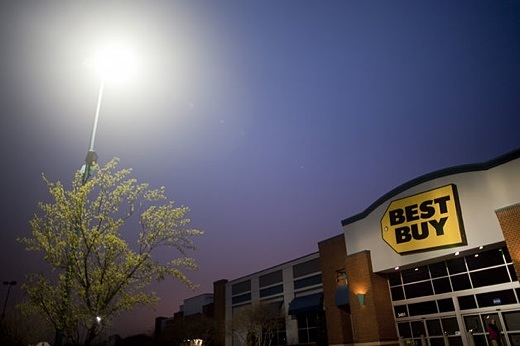 Image above: A daarkened Best Buy Store in Alexandria, Virginia. From original article
When Best Buy said yesterday it was closing 50 big stores and opening 100 smaller ones, the world’s largest electronics retailer was adjusting to reality: The era of big-box retail dominance is coming to an end.
Image above: A daarkened Best Buy Store in Alexandria, Virginia. From original article
When Best Buy said yesterday it was closing 50 big stores and opening 100 smaller ones, the world’s largest electronics retailer was adjusting to reality: The era of big-box retail dominance is coming to an end. The new mantra is small box. While Best Buy, Wal-Mart Stores Inc and Target Corp are still opening large stores, all are putting increasing emphasis on smaller ones. Best Buy plans to double the number of its smaller Best Buy Mobile stores by 2016. Wal-Mart is building as many as 100 small-format stores this year, while Target is opening five CityTarget locations.
After 50 years of putting mom and pops out of business, big-box retail is having a mid-life crisis. A slow economy has hurt same-store sales, narrowing margins at big stores. Meanwhile, consumers, armed with price-comparison technology, are visiting more stores seeking deals or exclusive merchandise rather than making one-stop, fill-the-cart excursions.
“We’re undergoing a seismic shift,” said Natalie Berg, an analyst with Planet Retail in London. “People are still cutting back. People are buying more products online so there is a real case for downsizing stores.”
Big-box retailers essentially come in two flavors: so- called category killers such as Best Buy that focus on one type of merchandise, and discounters like Wal-Mart and Target, which sell a broader range of goods.
Declining SalesSince the recession, big-box retailers have struggled. Until its third fiscal quarter last year, Wal-Mart had posted eight consecutive quarters of declining sales at stores open more than 12 months. Best Buy posted five straight quarters of profit decline before reporting a $2.6 billion loss on March 29, while analysts forecast declining same-store sales and profit for Target this year.
Since June 2009, when the recession officially ended, Wal- Mart shares have advanced 26 percent and Best Buy has dropped 28 percent, both trailing the 39 percent gain for the 32-company Standard & Poor’s 500 Retailing Index. Target shares gained 48 percent in that time.
Big-box retail was born in 1962. That’s the year that Wal- Mart, K-Mart and Target all opened their first large discount stores. As they grew, the new big boxes began offering broad selection and low prices to a growing population of suburbanites who had left the cities in their new cars, searching for their piece of the American Dream.
Big boxes boomed in the go-go 1990s. Fueled by an inflated stock market and loose credit, Americans expanded farther into the suburbs and filled their new homes with appliances and consumer goods, said John Lupo, a retired Wal-Mart executive who now sits on the board of AB Electrolux. The housing boom propelled the big-box retailers into the new millennium. Then came the crash and consumers pulled back.
Conspiring ForcesOther forces are conspiring against the big-box model. Baby Boomers no longer have kids at home and don’t need to stock up on food and packaged goods. Their kids are marrying later and delaying having their own children, meaning fewer are buying houses that need to be updated and furnished.
“Right now you have a trough in the need for big-box retail,” said Bryan Gildenberg, an analyst with the Cambridge, Massachusetts-based research firm Kantar Retail.
Hence the rush to open smaller stores. By 2016, Richfield, Minnesota-based Best Buy plans to have as many as 800 Mobile Stores, up from 305 now. It’s part of Chief Executive Officer Brian Dunn’s plan to generate revenue from warranties, accessories and connections between phones, tablets and other electronics.
The increasing emphasis on smaller stores still leaves room for big stores, according to Dunn.
Anytime, Anywhere“We see those stores as an important part of a network in conjunction with our small-box stores, our online capabilities and our on-phone capabilities that allow customers to reach us anytime, anywhere, anyhow they choose,” he said in a telephone interview. “While I don’t see this as a decline of the big boxes, the multi-channel approach that we are taking will require less square footage.”
Wal-Mart, which is based in Bentonville, Arkansas, is also sticking with big stores. While the company aims to add at least three times as many Neighborhood Markets as in 2011, it plans to add up to 150 supercenters, compared with 122 last year.
“The supercenter is still what works best for us,” said Deisha Galberth Barnett, a Wal-Mart spokeswoman. “We will continue to work to grow the presence of supercenters.”
Shoppers’ stampede online is also hurting big-box chains. The biggest beneficiary of that shift is Amazon.com Inc. (AMZN), which is grabbing market share from Wal-Mart, Best Buy and Target.
Online Purchases“The biggest challenge for big boxes is increasing consumer confidence in making online purchases,” said Matt Arnold, an analyst at Edward Jones & Co. in Des Peres, Missouri, who rates Best Buy and Wal-Mart as buys. “Best Buy is arguably more exposed than the Wal-Marts of the world that are heavy in the food, apparel and consumables category. In the case of consumer electronics, it comes down to price.”
If Best Buy and its big-box ilk are to survive, they’ll have to evolve and do a better job of integrating their brick- and-mortar locations with their Web stores, Arnold said.
“While big-box retailers are struggling, they aren’t going away,” Arnold said in a telephone interview. “They are shifting to smaller formats and investing in online retailing.”
See also: Island Breath: Economy of Scale - Little Box Stores 5/3/07 by Juan Wilson published in The Garden Island News .
No comments :
Post a Comment